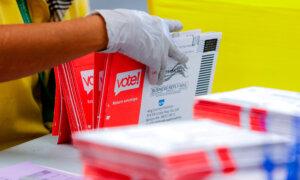A Chicago Board of Elections official said Sunday that he had “mistakenly” left out over 9,000 mail-in ballots from one of the races in last week’s Illinois state primary election, sparking renewed scrutiny around voting by mail in the run-up to the November presidential election.
The race in which the apparent tabulation error took place is between two Democrat candidates for state’s attorney in Chicago’s Cook County, Eileen O’Neill Burke and Clayton Harris III.
Ms. O'Neill Burke, a former appellate judge, is widely seen as the more tough-on-crime candidate of the two.
“We should be booming, and we’re not because of crime,” Ms. O’Neill Burke told The Associated Press. “This is something we can fix.”
Mr. Harris, a professor and former prosecutor who’s the more progressive candidate of the two, has said punishments should consider racial disparities.
The Chicago race is open because the current State’s Attorney Kim Foxx, who faced criticism for being soft on crime, declined to run a third time.
While the official results aren’t due to be released until April 9, projections indicate that Ms. O'Neill Burke has won the race by around 1,500 votes, with Mr. Harris conceding.
‘I Traded Speed for Accuracy’
One of the campaign issues in the Cook County state’s attorney race has been the future of Ms. Foxx’s controversial policy not to prosecute retail theft as a felony if the value of the stolen goods is below $1,000.Ms. O'Neill Burke has been critical of the policy.
“It doesn’t deter crime, it promotes it,” she said.
By contrast, Mr. Harris has vowed to keep it in place, if elected.
“If someone came and took my cellphone, is that cellphone worth a felony on your record? I do not think so,” he told AP. “We look at recidivism. We charge everyone appropriately.”
The Cook County state’s attorney’s office is the second largest in the country, after Los Angeles.
He said that election judges would be processing and counting roughly 13,086 mail-in ballots that had already been reviewed for timeliness, signature verification, and voter histories, with the vast majority of these received back via drop box on Election Day (March 19).
Around 9,000 of these hadn’t been counted in the initial tally, with Mr. Bever providing an update on the fate of the initially missing ballots.
“I made an error in reporting the number of Vote By Mail ballots received back on Monday, March 18 before Election Day that should have been included in the ‘received by Election Day’ numbers,” Mr. Bever said in the March 24 update.
“Approximately 9,143 Vote By Mail additional ballots received back on Monday should have been included in this ‘received by Election Day’ number that would be processed and counted after Election Day, March 19,” he continued.
The elections official said that the missing ballots had been secured in a receiving cage until they could be processed by scanning machines for signature verification and to rule out possible double-voting.
He added that the missing ballots were inspected, processed, and counted by election judges between March 22 and March 23, and are already reflected in the unofficial results.
‘Sounds Fishy’
The incident drew scrutiny and criticism on social media, where a report about it was shared by the End Wokeness account, which pointed out that many of the ballots were from dropboxes, where postmarks aren’t required.“Drop boxes also are sketchy and just invite cheating and mistakes. Democrat-run elections are rife with fraud and we see it happening more and more,” he added.
Voting by mail has been the subject of increased scrutiny and criticism following the 2020 presidential election, which former President Donald Trump claims was marred by irregularities and fraud that he says cost him a win.
The study was based on data obtained from a Heartland/Rasmussen survey conducted in December 2023, which revealed that roughly one in five mail-in voters, or 20 percent, admitted to actions that could be potentially fraudulent in the presidential election.
After the researchers carried out additional analyses of the raw data, they concluded that there was a higher percentage of fraudulent mail-in ballots. They now believe that 28.2 percent of people who voted by mail in 2020 committed at least one type of behavior that is, “under most circumstances, illegal,” and so potentially amounts to voter fraud.
A Heartland Institute research editor and research fellow who was involved in the study explained to The Epoch Times that there are narrow exceptions where a surveyed behavior may be legal, like filling out a mail-in ballot on behalf of another voter if that person is blind, illiterate, or disabled, and needs assistance.
The new study found that, absent the huge expansion of mail-in ballots during the pandemic, President Trump would most likely have won.







